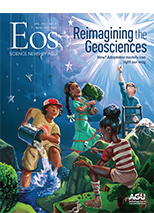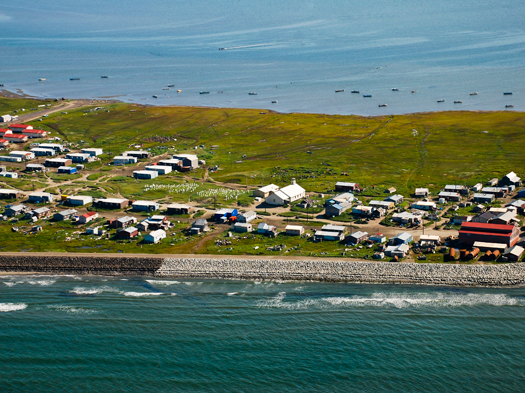Reimagining the Geosciences

• An Unfought Geoscience Battle in U.S. Prisons
• The Two-Year On-Ramp
• Ten Steps to Protect BIPOC Scholars in the Field
• Reframing the Language of Retreat
• Accessibility and Fieldwork
• Mentorship During a Pandemic
• The Challenges of Fieldwork for LGBTQ+ Geoscientists
• Perspectives on Parenting While Researching
• Students Learn New Skills with Scientist-in-Training Programs
• Shaping the Future of Science
When faced with the looming effects of climate change along coasts—larger storms, rising seas, flooding, and eroding shorelines—arguing to promote linguistic framing of climate change–driven migration may seem like a fool’s errand. Does anyone care what it’s called if hundreds of millions of people globally—up to 13.1 million people in the United States alone [Hauer et al., 2016]—relocate from coastlines en masse before 2100? Should anyone spend time considering how to title the newest report about climate-driven migrations when what are needed are data, analysis, policy changes, and cultural shifts that will safeguard the lives, livelihoods, infrastructure, and economies forced to deal with that migration? Does it really matter whether people are “retreating” or “relocating” when it’s still unclear how to deal realistically with the ocean rising up to 1.8 meters above the ground on which our homes are sitting?
We think it does matter.
Implicit in terms like managed retreat, forced migration, community relocation, and others are assumptions about who is deciding what is appropriate adaptation and how those decisions influence, suggest, or require compliance. How and, especially, by whom these plans are developed will have substantial impacts on affected or relocated people’s lives. These impacts are particularly critical for individuals in marginalized communities in the United States, who will likely endure disproportionate hardship from climate and environmental risks and who have historically suffered under decisions made by people outside their communities.
We want to start a discussion about the assumptions and implications conveyed by the various terms used to describe the anticipated large-scale movements of people and communities away from coasts.
Managed Retreat
The most common term used to describe the movement of people away from coasts is managed retreat, a concept that emerged from coastal engineers. The term has been used largely to describe the physical movement of built infrastructure, and it only subsequently has included the physical movement of people. Also encompassed in the term are the policies that facilitate these movements. Recent scientific and policy research has tried to reconceptualize the idea of managed retreat so that it is more inclusive of social consequences—such as the cultural and psychological risks that accompany retreat—or has suggested actions such as reparations to address risk that has accumulated over time for specific disenfranchised populations [Siders et al., 2019].
However, within the managed retreat framework—with its focus on buildings, property, city infrastructure, zoning, property rights, and the strategic planning and political will necessary to coordinate all of these—scientists use data to help governing authorities and businesses make plans and policies to entice municipalities, property owners, and developers away from coasts. Those making the plans and policies often suggest that such a mechanism saves people from both sea level rise and “their own bad decisions.” At first blush, this is an enticing way to think about climate change adaptation, offering a “best solution”—and it is accurately titled as managing retreat. But the emerging use of eminent domain to remove people from coastal locations, such as along the U.S. East and Gulf Coasts, is an example of how managed retreat sometimes leads to plans of action that are enacted upon a citizenry instead of in partnership with a citizenry.
There are three critical flaws in this framework.
First, affected people are often missing altogether from policy and planning discussions about managed retreat, and when they are present, they are abstracted and homogenized. It is as though they do not have unique lives or histories, differences in bank balances, varying access to childcare, valid opinions, ancestral knowledge of place, or varying perspectives about what success looks like in their own lives and relocations. In some cases, people have been described as being part of the problem—obstacles to achieving the goals of managed retreat.
As social scientists who study community-led relocation, we can attest to the number of researchers, disaster response professionals, and journalists who have asked us about communities’ “unwillingness to move,” about the “stubbornness of some people,” and about the onus of financing relocations “being on the individual.” If managed retreat works against people’s own assessments of risk, desires, and decision-making, it is not an inclusive adaptation plan, and it can further marginalize the very communities it is supposedly designed to support. What people think of their own lives, place, and culture matters.
For example, Indigenous Peoples, whose lands settlers stole and now inhabit—and who are on the front lines of climate displacement—are connected to the land through Indigenous worldviews that hold the land to be their ancestor. When displaced from the land, people become displaced from their culture. Indigenous Peoples understand this dynamic and can be resistant to moving for this very reason.
Second, the normative assumptions about “the best solution for the greatest number of people” wrapped up in the managed retreat language often leave out the very people who bear the most extreme burdens of the climate crisis. In a process managed by outside entities—especially powerful ones such as scientific institutions, governments, and corporations—speaking and acting for the people who are actually moving run the risk of continuing and expanding the historical oppression of rural, minoritized, Indigenous, and undocumented communities.
Consider the sacrifices of Indigenous communities on Bikini Atoll, who were moved repeatedly by the U.S. government for nuclear testing on the island and who today continue to experience effects of displacement and severe environmental and health devastation and injustices. Consider how the damming of the Amazon displaced more than a dozen Indigenous groups and how Andrew Jackson’s purchase of Georgia led to the Trail of Tears death march for an estimated 60,000 Native Americans from east of the Mississippi River to what is now Oklahoma.

Today a number of tribal communities and Indigenous Peoples live on the Mississippi Delta lowlands, which are sinking as seas are rising. There are also Indigenous communities on low-lying islands all across the South Pacific. With a new era of relocation linked to climate change, we can anticipate these and similar communities bearing the burden of picking up their cultures and moving again. It is critical to allow these communities to create, invent, and decide their own futures.
Third, by not focusing on the lived experiences of people being relocated and on the differences among communities who need to move, there is a greater likelihood that resources will be disproportionately allocated away from politically marginalized and economically poor communities [Siders et al., 2019; Marino, 2018] or that the provision of resources will stop once people are relocated.
When scientists, policy makers, and planners say managed retreat, their sights are trained on putting physical space between encroaching waters and communities—on retreating. To the point that people and infrastructure do leave, such efforts succeed. But there is so much that can be done better.
More Inclusive Language
Shifting from “managed retreat” to language that is more inclusive of who and what is included in “community” and that upholds the varying voices, opinions, knowledges, and lived experiences of those physically moving is more than a semantics issue; it also involves logistic and policy elements that can incite changes in practices related to people moving from coastal regions.
The term community-led relocation, for example, includes consideration of the complex tapestry of people who leave a place they have inhabited to settle in another, as well as the fact that these community tapestries are bound not by geography but by relationships and practice. “Community led” also highlights the importance of community engagement, input, and leadership in decision-making, visioning, planning, and implementation [Marino et al., 2019].
Unlike with “managed retreat,” “community-led relocation” encourages us to see that success means helping people to stay safe and healthy and feel satisfied in a new location. The term also encourages us to foster plans of action that emphasize the logistics of perpetuating culture after resettlement, such as considering how houses are constructed and how people physically dwell in relation to one another, as well as establishing community gathering spaces for cultural and ceremonial practices and ways to maintain food sovereignty and access to traditional foods, medicines, and subsistence practices.

Social scientists know that simply using the word community does not mean everyone within that designation agrees to a single or simple solution [Faas and Marino, 2020]. But framing sea level rise–driven migration as taking place within a community instead of as involving retreat from a territory allows space for dialogue to address solutions that make sense to the people moving as opposed to focusing on terminology originally meant to describe infrastructures and assets. If the people most affected by relocation are not involved in the planning process, their needs—physical and cultural—are unlikely to be met. Their communities will be moved to places that are not set up for or prepared to accommodate their cultures, which is how cultural affirmations like Native languages, traditions, foundations, and ties to land and sustainability can be erased.
An Open Conversation
A critical question to consider is, How do people relocate with their cultures intact? If intact means immutable and unchanged, then it is impossible. However, Indigenous Alaskans and many communities throughout the Pacific, for example, have long traditions of migration. These communities show that dignity and self-governance in movement as a response to changing coasts are certainly possible—but only if local authority is central to the conversation.
Our intent here is not to prescriptively determine the language to associate with climate-driven relocation. Even with “community” attached to them, words like relocation can have deep-rooted negative connotations. Rather, we want to invite an open conversation to shift the framing from one of managed retreat to one that is more inclusive of people, cultures, and lifeways. If people do not see themselves in the framing, if it is being done for them as opposed to with them, the process reverts to adopting the historically problematic best solution.
As we’ve described, the best solution in the current framing of managed retreat is based predominantly on economic measures while discounting nonmaterial considerations like histories, practices, affective experiences, and ways of life that are essential in thriving communities.
We recognize that no single framing will work for everyone. In determining how such framing can be more inclusive, it is critical for planners, engineers, scientists, policy and decision makers, and other professionals involved to engage in open and ongoing dialogue with community leaders and organizers who have long been working on and advocating for community-led, preventive actions. It is also critical to build flexibility into the relocation process to allow a community to decide for itself how best to enable its own physical and cultural continuity. In addition, as part of relocation planning, there needs to be an evaluative process to determine whether and how a community group was involved in decision-making at every step, from initial visions to planning to implementation.
The risks and challenges borne by communities at risk of displacement often are founded on centuries of injustices. The least that planners, engineers, scientists, and others involved in researching and implementing community relocation plans can do, collectively, is to create inclusive language and frameworks that promote just community relocations and resettlements.
Acknowledgments
We express deep gratitude to our friends and relatives who have provided wisdom and guidance over the years on the processes discussed in this article and so much more.
